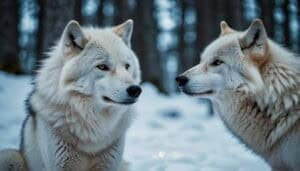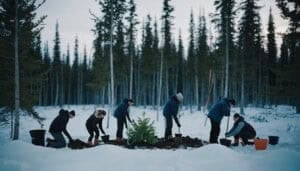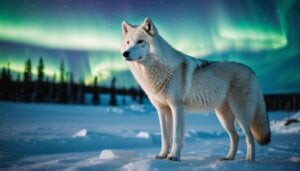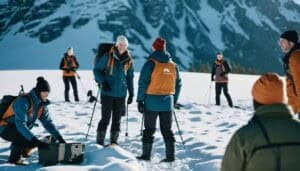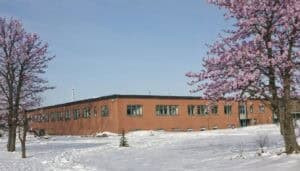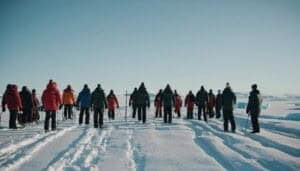Introduction
Community leaders play a crucial role in the protection and conservation of Arctic wolves. Their efforts encompass a wide range of activities, from influencing legislation and implementing specific conservation initiatives to collaborating with scientists and raising public awareness
Indigenous leaders bring valuable traditional knowledge and cultural significance to these efforts, while educational programs and public outreach help ensure community involvement
Throughout this article, we will explore the various ways in which community leaders contribute to the protection of Arctic wolves, examining their influence on policies, the initiatives they spearhead, and the partnerships they form to safeguard these majestic creatures
Community Leaders and Arctic Wolf Conservation Policies
Community leaders are at the forefront of advocating for and shaping policies that protect Arctic wolves. Their influence is vital in ensuring that effective and sustainable conservation measures are implemented
By leveraging their positions and networks, they can drive legislative changes, advocate for increased protections, and work towards the long-term survival of Arctic wolves
Influence on Legislation
Community leaders play a pivotal role in influencing legislation related to Arctic wolf conservation. They often serve as the bridge between the local communities, policymakers, and conservation organizations
Their firsthand knowledge of the local environment and the needs of the wolves enables them to provide valuable insights that inform policy decisions. For instance, leaders in Arctic regions may lobby for stricter anti-poaching laws or more significant penalties for those who harm wolf populations
Their advocacy efforts can lead to the introduction of new laws that protect critical habitats, regulate hunting practices, and ensure sustainable development in wolf-inhabited areas
A notable example is the collaborative effort between community leaders and government officials in Canada, where stricter regulations have been implemented to protect the Arctic wolf’s habitat from industrial activities
These leaders have successfully lobbied for the designation of protected areas and the implementation of sustainable land-use practices, demonstrating the significant impact of their legislative advocacy
Advocacy and Lobbying Efforts
Beyond influencing legislation, community leaders engage in continuous advocacy and lobbying efforts to maintain and strengthen conservation policies. They organize campaigns, participate in public hearings, and use their platforms to raise awareness about the importance of protecting Arctic wolves
These leaders often collaborate with non-governmental organizations (NGOs) and conservation groups to amplify their voices and reach a broader audience
For example, in Alaska, community leaders have partnered with wildlife conservation groups to launch campaigns highlighting the threats to Arctic wolves from climate change and human activities
By mobilizing community members and working with media outlets, they have been able to garner public support and pressure policymakers to take action. Their efforts have led to increased funding for conservation programs and more robust enforcement of existing wildlife protection laws
Policy Implementation Strategies
Once policies are in place, the role of community leaders extends to ensuring their effective implementation. They oversee and coordinate various activities to ensure compliance with conservation regulations. This may involve working with local authorities, monitoring wildlife populations, and engaging with community members to promote sustainable practices
Community leaders in Greenland have been instrumental in implementing policies that protect Arctic wolves. They have developed comprehensive strategies that include habitat restoration projects, community education programs, and the establishment of wildlife corridors to facilitate wolf movement
By actively involving the local population in these efforts, they ensure that conservation policies are not only enforced but also embraced by the community
Moreover, community leaders play a critical role in adapting policies to changing conditions. For instance, as climate change impacts the Arctic environment, these leaders continuously assess the effectiveness of existing measures and advocate for necessary adjustments. Their proactive approach ensures that conservation efforts remain relevant and effective in the face of evolving challenges
Specific Initiatives by Community Leaders
Community leaders spearhead various initiatives to protect Arctic wolves, addressing immediate threats and promoting long-term conservation
These initiatives often involve habitat protection, anti-poaching measures, and community-based monitoring programs. Their proactive approach ensures that Arctic wolves have a secure environment and are less vulnerable to human activities
Habitat Protection Projects
One of the primary initiatives led by community leaders is habitat protection. Arctic wolves depend on vast, undisturbed territories for hunting and breeding. Community leaders work to safeguard these areas from industrial activities, such as mining and oil drilling, that threaten to disrupt the wolves’ natural habitat
For example, in the Arctic regions of Canada, community leaders have collaborated with environmental organizations to establish protected areas specifically for Arctic wolves
These areas are off-limits to commercial activities, ensuring that wolves have access to undisturbed land for their survival. Leaders also promote sustainable land-use practices, such as controlled tourism and regulated resource extraction, to minimize human impact on wolf habitats
Anti-Poaching Measures
Poaching poses a significant threat to Arctic wolves, and community leaders are at the forefront of combating this illegal activity. They implement anti-poaching measures that include surveillance, law enforcement cooperation, and community education
In Russia, community leaders have set up anti-poaching patrols composed of local volunteers trained to monitor wolf populations and report illegal hunting activities. These patrols work in collaboration with law enforcement agencies to ensure swift action against poachers
Additionally, leaders conduct awareness campaigns to educate local communities about the importance of wolves to the ecosystem and the legal consequences of poaching
Community-Based Monitoring Programs
Community-based monitoring programs are another effective initiative led by community leaders. These programs involve local residents in the active monitoring of Arctic wolf populations and their habitats. By engaging the community, leaders foster a sense of ownership and responsibility towards conservation efforts
In Alaska, community leaders have established monitoring programs where local hunters and fishermen report sightings of Arctic wolves and any signs of habitat disturbance. This data is crucial for tracking wolf populations and identifying potential threats early
The involvement of the local community not only provides valuable information but also ensures that conservation efforts are culturally appropriate and widely supported
Success Stories and Impact
The impact of these initiatives is evident in several success stories across the Arctic region
In Norway, community-led habitat restoration projects have resulted in a significant increase in Arctic wolf numbers. Leaders worked with local landowners to restore degraded landscapes, planting native vegetation and removing barriers to wolf movement. These efforts have created a more hospitable environment for wolves, leading to healthier and more stable populations
Similarly, in Greenland, anti-poaching initiatives led by community leaders have drastically reduced illegal hunting. Through a combination of strict enforcement and community education, the local population has become more supportive of wolf conservation efforts
This collaborative approach has strengthened the relationship between conservationists and the community, ensuring ongoing protection for Arctic wolves
Future Directions
Looking ahead, community leaders continue to innovate and adapt their initiatives to address emerging challenges
Climate change, for instance, poses new threats to Arctic wolf habitats. Leaders are exploring strategies to mitigate its impact, such as advocating for climate-resilient conservation policies and promoting research on how changing environmental conditions affect wolf populations
Moreover, community leaders are increasingly leveraging technology to enhance their conservation efforts. Drones, remote sensing, and GPS tracking are being used to monitor wolf movements and habitats more efficiently. These technological advancements allow for more accurate data collection and better-informed decision-making
Collaboration with Scientists and Conservationists
Community leaders play an essential role in fostering collaboration between local communities, scientists, and conservationists
This collaboration is crucial for the development and implementation of effective conservation strategies for Arctic wolves. By combining local knowledge with scientific research, these partnerships ensure a holistic approach to wildlife conservation
Joint Research Projects
Community leaders often partner with scientists to conduct joint research projects focused on Arctic wolf conservation. These projects aim to gather data on wolf behavior, population dynamics, and habitat use, which are critical for developing informed conservation strategies
For instance, in Canada, community leaders have collaborated with university researchers to study the impact of climate change on Arctic wolves. Together, they conduct field studies to monitor changes in prey availability, wolf migration patterns, and reproductive success
This research provides valuable insights into how environmental changes affect wolf populations, informing adaptive management practices that can mitigate negative impacts
Data Sharing and Analysis
Effective conservation efforts require the sharing and analysis of data collected from various sources. Community leaders facilitate this process by acting as intermediaries between local communities and scientific institutions. They ensure that data is accurately collected, shared, and analyzed to support conservation initiatives
In Alaska, community leaders have established data-sharing agreements with conservation organizations and government agencies
These agreements enable the pooling of data from wildlife tracking programs, ecological surveys, and community observations. The combined data sets provide a comprehensive understanding of Arctic wolf populations and their habitats, allowing for more effective conservation planning and decision-making
Wildlife Tracking and Observation
Tracking and observing Arctic wolves in their natural habitat is essential for understanding their behavior and ecology. Community leaders collaborate with scientists to implement wildlife tracking programs that use advanced technologies to monitor wolf movements and interactions
For example, in Greenland, community leaders have partnered with conservationists to deploy GPS collars on Arctic wolves. These collars transmit real-time data on the wolves’ locations, movement patterns, and habitat use
The information gathered helps researchers identify critical habitats, migration corridors, and potential threats. Community leaders play a key role in ensuring the ethical and safe handling of wolves during collaring operations, as well as in interpreting the data within the context of local ecological knowledge
Benefits of Collaboration
The collaboration between community leaders, scientists, and conservationists yields numerous benefits for Arctic wolf conservation. One significant advantage is the integration of traditional knowledge with scientific research
Indigenous community leaders, in particular, contribute valuable insights based on generations of experience and observation of the natural environment. This knowledge complements scientific data, leading to more robust and culturally relevant conservation strategies
Another benefit is the increased capacity for comprehensive conservation efforts. By working together, community leaders and scientists can undertake large-scale projects that would be challenging to achieve independently. Joint efforts in habitat restoration, population monitoring, and threat mitigation are more effective when informed by both local knowledge and scientific expertise
Moreover, collaborative projects often receive greater support from funding agencies and government bodies. The demonstrated partnership between community leaders and scientific institutions enhances the credibility and impact of conservation proposals, leading to increased financial and logistical support
Case Studies of Successful Collaborations
Several successful collaborations highlight the positive outcomes of partnerships between community leaders and scientists. In Norway, a collaborative project focused on restoring wolf habitats involved both local community leaders and ecologists
The project successfully reestablished native vegetation, improved prey availability, and created safe corridors for wolf movement. As a result, the local wolf population showed signs of recovery, demonstrating the effectiveness of joint conservation efforts
In Russia, community leaders and biologists worked together on a project to understand the genetic diversity of Arctic wolves. By collecting genetic samples and analyzing them in laboratories, they identified distinct wolf populations and their unique adaptations to different environments. This information guided conservation actions to preserve the genetic integrity and resilience of Arctic wolves
Future Prospects for Collaboration
Looking to the future, the collaboration between community leaders and scientists is expected to deepen and expand. Emerging technologies such as drone surveillance, remote sensing, and environmental DNA (eDNA) analysis offer new opportunities for innovative research and monitoring
Community leaders are increasingly involved in the application and interpretation of these technologies, ensuring that they align with local conservation goals and ethical considerations
Furthermore, as the impacts of climate change intensify, the need for collaborative adaptive management approaches becomes more critical. Community leaders and scientists must work together to develop flexible and responsive conservation strategies that can address the dynamic challenges facing Arctic wolves and their habitats
Role of Indigenous Leaders in Arctic Wolf Conservation
Indigenous leaders are integral to Arctic wolf conservation efforts, bringing a unique perspective rooted in traditional knowledge and cultural significance. Their involvement ensures that conservation practices respect and incorporate indigenous values, leading to more holistic and effective protection strategies for Arctic wolves
Traditional Knowledge Integration
Traditional ecological knowledge (TEK) held by indigenous communities provides invaluable insights into Arctic wolf behavior, ecology, and interactions with the environment. Indigenous leaders play a critical role in integrating this knowledge with contemporary conservation science to develop more nuanced and effective management strategies
In regions like Alaska and Northern Canada, indigenous leaders work closely with scientists to document and apply TEK in conservation planning. For example, elders and hunters share observations about wolf migration patterns, prey availability, and habitat changes
This information complements scientific data, offering a comprehensive understanding of the factors affecting Arctic wolf populations. The integration of TEK helps identify critical habitats, understand seasonal behaviors, and predict the impacts of environmental changes on wolf populations
Indigenous-Led Conservation Programs
Indigenous leaders spearhead numerous conservation programs that reflect their communities’ values and priorities. These programs often focus on sustainable land management, habitat restoration, and community education, ensuring that conservation efforts are culturally relevant and widely supported
One notable example is the Tundra Conservation Initiative in Greenland, led by indigenous leaders in collaboration with local and international organizations. This initiative focuses on protecting the tundra ecosystem, which is vital for Arctic wolves and other wildlife
Indigenous leaders organize community-driven projects that include habitat restoration, sustainable hunting practices, and environmental monitoring. By involving the local population in these efforts, they foster a sense of ownership and responsibility towards conservation
Cultural Significance of Arctic Wolves
For many indigenous communities, Arctic wolves hold profound cultural and spiritual significance. Indigenous leaders emphasize the importance of respecting and protecting wolves as part of their heritage and worldview. This cultural perspective enhances the moral and ethical dimensions of conservation efforts
In Nunavut, Canada, the Inuit community regards Arctic wolves as important figures in their mythology and oral traditions. Indigenous leaders incorporate these cultural narratives into conservation education programs, helping to strengthen the connection between the community and wolf conservation. By highlighting the cultural significance of wolves, leaders inspire greater community support and participation in conservation activities
Collaborative Efforts with Indigenous Communities
Collaborative conservation efforts that involve indigenous communities are more likely to succeed due to the deep-rooted connections between indigenous people and their environment. Indigenous leaders facilitate these collaborations by ensuring that conservation projects respect indigenous rights, knowledge, and governance systems
In Russia, indigenous leaders have partnered with conservationists and government agencies to create protected areas that safeguard both Arctic wolves and indigenous lands. These protected areas are managed using traditional practices that have sustained the ecosystem for generations
Indigenous leaders play a crucial role in decision-making processes, ensuring that conservation policies align with their cultural values and sustainable practices
Case Studies of Indigenous Leadership in Conservation
Several case studies highlight the positive impact of indigenous leadership on Arctic wolf conservation. In Alaska, the Gwich’in Nation has been at the forefront of protecting the Arctic National Wildlife Refuge, a critical habitat for Arctic wolves
Indigenous leaders have led advocacy efforts to prevent oil drilling in the refuge, emphasizing the importance of preserving the ecosystem for future generations. Their activism has garnered international support and helped delay potentially harmful industrial activities
In Canada, the Dene and Métis leaders have implemented community-based monitoring programs to track the health and movements of Arctic wolves. These programs combine traditional tracking methods with modern technology, providing accurate and comprehensive data on wolf populations. The success of these programs demonstrates the value of indigenous knowledge and leadership in wildlife conservation
Future Directions for Indigenous Leadership
Looking ahead, the role of indigenous leaders in Arctic wolf conservation is expected to expand as their contributions gain greater recognition and support
Indigenous-led conservation initiatives are increasingly being integrated into national and international conservation frameworks. This trend is supported by growing awareness of the importance of respecting indigenous rights and knowledge in biodiversity conservation
Moreover, indigenous leaders are advocating for greater involvement in decision-making processes at all levels of conservation governance. They call for policies that recognize indigenous land rights, support traditional knowledge systems, and provide funding for indigenous-led conservation projects. Their leadership is essential for ensuring that conservation efforts are inclusive, equitable, and effective
Awareness and Education Efforts
Community leaders are pivotal in raising awareness and educating the public about the importance of protecting Arctic wolves. Through targeted campaigns, workshops, and outreach programs, they mobilize communities, inspire action, and ensure that conservation efforts receive widespread support
Public Awareness Campaigns
Public awareness campaigns are a cornerstone of conservation efforts led by community leaders. These campaigns aim to inform the public about the threats facing Arctic wolves and the importance of their conservation. By leveraging various media platforms, leaders can reach a broad audience and foster a sense of urgency and responsibility towards protecting these animals
In Canada, community leaders have launched successful campaigns using social media, local newspapers, and radio broadcasts to highlight the plight of Arctic wolves. These campaigns often feature compelling narratives, stunning visuals, and testimonials from local residents and experts
By raising awareness about issues such as habitat destruction and poaching, these campaigns motivate the public to support conservation initiatives and adopt sustainable practices
School and Community Workshops
Education is a powerful tool for conservation, and community leaders often organize workshops in schools and communities to educate people about Arctic wolves. These workshops aim to provide participants with a deeper understanding of wolf ecology, behavior, and the challenges they face
In Alaska, community leaders conduct interactive workshops in schools, where students learn about Arctic wolves through hands-on activities, presentations, and field trips. These educational programs are designed to inspire the younger generation to become advocates for wildlife conservation
Similarly, community workshops engage local residents in discussions about the role of Arctic wolves in the ecosystem and how they can contribute to conservation efforts
These workshops often include collaborations with wildlife biologists and conservationists, who share their expertise and experiences. By providing accurate and engaging information, these workshops help demystify Arctic wolves and counteract negative stereotypes and misconceptions about these animals
Media and Social Media Outreach
Effective use of media and social media is crucial for spreading conservation messages quickly and widely. Community leaders utilize these platforms to engage with the public, share information, and encourage community involvement in conservation efforts
In Norway, community leaders have created social media pages dedicated to Arctic wolf conservation. These pages regularly post updates on conservation projects, share educational content, and organize online events such as webinars and live Q&A sessions with experts. The interactive nature of social media allows for real-time engagement with followers, fostering a community of informed and active conservation supporters
Additionally, traditional media outlets such as television and newspapers are used to reach audiences who may not be active on social media. Community leaders often participate in interviews, write opinion pieces, and produce documentaries that highlight the importance of protecting Arctic wolves. These efforts help maintain public interest and support for conservation initiatives
Community Engagement and Participation
Engaging the local community is essential for the success of conservation efforts. Community leaders organize various events and activities to involve residents in protecting Arctic wolves and their habitats
In Greenland, community leaders host annual “Arctic Wolf Days,” which include educational talks, wildlife tours, and community clean-up events in wolf habitats. These events are designed to celebrate the presence of Arctic wolves and educate the public about their ecological significance. By actively involving the community in these events, leaders foster a sense of pride and responsibility towards wolf conservation
Furthermore, community leaders encourage local residents to participate in citizen science projects
These projects involve community members in collecting data on wolf sightings, tracks, and other ecological indicators. The data gathered is used to monitor wolf populations and inform conservation strategies. Citizen science not only provides valuable data but also empowers community members to take an active role in conservation
Challenges and Solutions in Awareness and Education Efforts
Despite the success of many awareness and education initiatives, community leaders face several challenges. One significant challenge is overcoming cultural and economic barriers that may limit community engagement. In some regions, economic activities such as hunting and resource extraction are deeply ingrained in local cultures and economies, making it difficult to promote conservation
To address these challenges, community leaders adopt culturally sensitive and economically viable approaches. For instance, they collaborate with local businesses to develop eco-tourism initiatives that provide alternative livelihoods while promoting conservation. These initiatives create economic incentives for protecting Arctic wolves and their habitats
Another challenge is combating misinformation and negative perceptions about Arctic wolves. Community leaders work to dispel myths and highlight the ecological benefits of wolves through education and positive storytelling. By emphasizing the interconnectedness of ecosystems and the role of wolves in maintaining ecological balance, they shift public attitudes towards conservation
Future Directions in Awareness and Education
Looking forward, community leaders are exploring innovative ways to enhance awareness and education efforts
Virtual reality (VR) and augmented reality (AR) technologies offer new opportunities to create immersive educational experiences. For example, VR simulations can transport users to the Arctic tundra, allowing them to observe Arctic wolves in their natural habitat and learn about conservation challenges firsthand
Additionally, community leaders are developing mobile apps and online platforms that provide interactive educational content about Arctic wolves. These digital tools can reach a global audience and engage younger generations who are adept at using technology
Conclusion
Community leaders play a multifaceted and indispensable role in the protection of Arctic wolves
Their efforts span from shaping and advocating for conservation policies to implementing specific initiatives, collaborating with scientists, and raising public awareness. Indigenous leaders bring unique traditional knowledge and cultural significance to conservation strategies, enriching the overall approach to protecting these majestic creatures
By influencing legislation, community leaders ensure that robust legal frameworks are in place to safeguard wolf habitats and populations. Their advocacy and lobbying efforts mobilize public and political support for stronger protections and effective enforcement of conservation laws
Implementation strategies overseen by community leaders ensure that policies are not only enacted but also effectively applied on the ground
Specific initiatives, such as habitat protection projects and anti-poaching measures, directly address the threats faced by Arctic wolves. Community-based monitoring programs engage local residents in conservation activities, fostering a sense of ownership and responsibility towards wildlife protection
Collaboration with scientists and conservationists enhances the knowledge base and effectiveness of conservation efforts, combining traditional ecological knowledge with modern scientific research
Indigenous leaders, in particular, play a crucial role in integrating cultural values and traditional knowledge into conservation practices. Their leadership ensures that conservation efforts are culturally relevant, sustainable, and respectful of indigenous rights and governance systems
Awareness and education campaigns led by community leaders engage and inform the public, building widespread support for Arctic wolf conservation
As community leaders continue to innovate and adapt their strategies to address emerging challenges, the future of Arctic wolf conservation looks promising. Their dedicated work, combined with strong partnerships and community involvement, paves the way for a sustainable future where Arctic wolves can thrive


